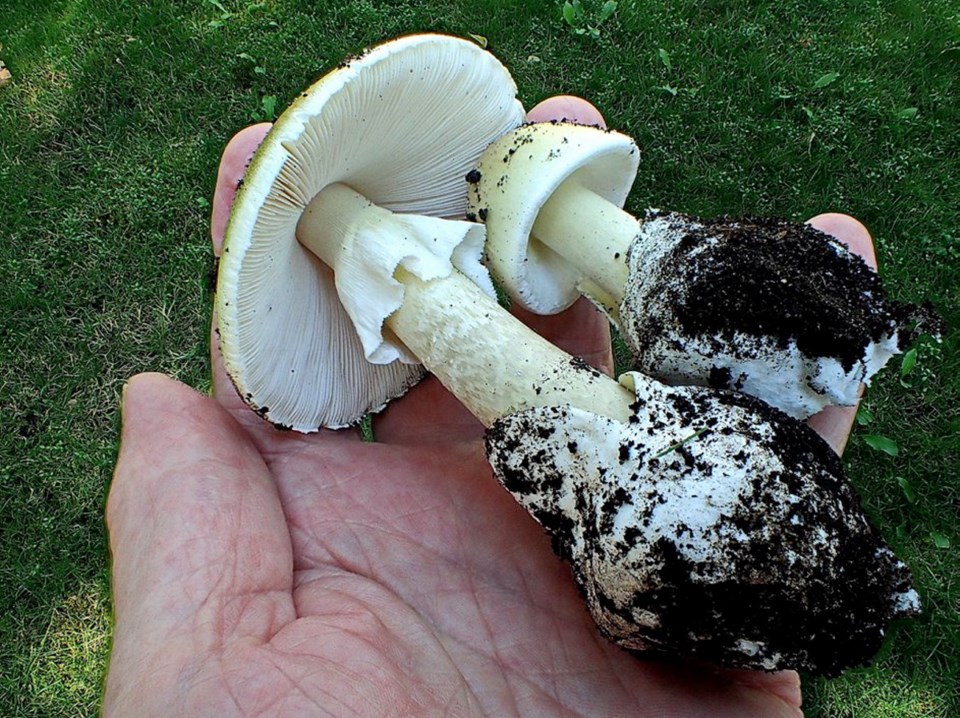The B.C. Centre for Disease Control is warning people to use extreme caution when foraging or eating wild mushrooms.
This year, B.C. is expected to have a record year for mushroom poisoning calls. By Sept. 30, Poison Control had received 201 calls, virtually the same number as in all of 2018. The 202 calls that year was up from 161 in 2017.
Two-thirds of mushroom poisonings this year have involved children under the age of five, said Poison Control pharmacist Raymond Li.
“It is important to be aware of dangers from consuming unidentified mushrooms, especially death cap mushrooms,” Li said in a statement. “We would like to remind mushroom hunters, parents and pet owners to be vigilant as they enjoy city, parks, forests and even their own backyard.”
The death cap mushroom is popping up more frequently in Victoria, the south Island, the Gulf Islands, Metro Vancouver and the Fraser Valley. The death cap is the most poisonous mushroom in the world. In B.C., it’s most often found in urban areas rather than forests.
In 2016, a three-year-old Victoria boy died after eating a death cap mushroom picked in the city. His family decided to speak out about his death to warn others of the dangers of picking mushrooms without proper knowledge.
Since then, no one has died from consuming death caps, but two dogs are believed to have been fatally poisoned by them this year.
“With increased appearances of death cap mushrooms across B.C. comes increased risk of exposures,” said Paul Kroeger, co-founder of the Vancouver Mycological Society, in a statement. “We urge recreational mushroom hunters to use caution and common sense when foraging wild fungi.”
There are many other varieties of wild mushrooms that are less toxic than death caps but can also cause severe illness.
Tips to stay safe while mushroom hunting:
• Don’t eat anything you’re unsure of.
• Only pick and eat mushrooms that are well known to be edible and easy to distinguish from poisonous varieties. If you suspect you’ve consumed a poisonous mushroom, call the Drug and Poison Information Centre 24-hour phone line at 1-800-567-8911 and seek medical attention immediately.
• Only hunt for mushrooms in safe terrain and exercise extreme caution if in remote areas.
• Save one of each kind of mushroom so their identities can be confirmed should symptoms develop.
Death cap mushrooms are believed to kill more people worldwide than any other mushroom. Native to Europe, the mushrooms are thought to have been introduced to B.C. on the roots of imported hardwood trees, such as the hornbeam, a popular variety that was planted widely in Vancouver in the 1960s and 1970s.
Death caps are particularly dangerous because of their resemblance to edible varieties of mushrooms. They can be mistaken for edible puffballs when young, or the Asian straw mushroom when older. Symptoms of poisoning include nausea, vomiting, watery diarrhea, low blood pressure, liver failure and kidney failure.
Illness begins eight to 12 hours after ingestion, beginning with gastrointestinal symptoms such as vomiting and diarrhea, followed by apparent recovery.
Gastrointestinal symptoms recur and damage to the kidney and liver progresses over the next three to six days.
For more information, check the website for the B.C. Centre for Disease Control at bccdc.ca/ health-info/prevention-public-health/death-cap-mushrooms.



